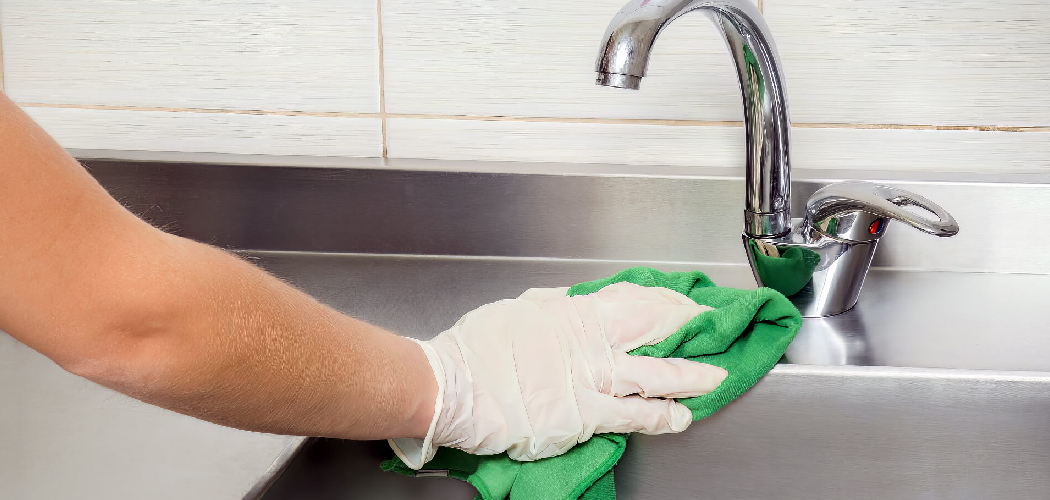Rust stains in bathtubs can be an unsightly and frustrating problem. These stains are often caused by hard water containing high levels of iron, rusty plumbing systems, or metal items left in the tub for extended periods. Over time, these stains can become increasingly stubborn and may even risk permanently discoloring or damaging the tub’s surface. Addressing rust stains promptly is crucial to maintain a clean and sanitary bathroom environment. Not only does this prevent long-term damage, but it also enhances the appearance of your bathroom and ensures a more hygienic space.
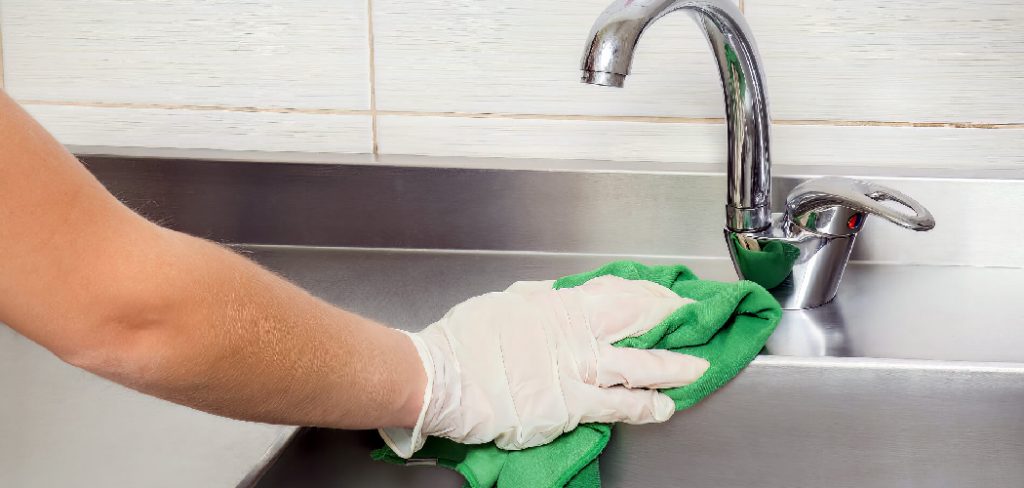
This article will explore effective and safe methods on how to get rid of rust stains in tub surfaces made from various materials, including porcelain, fiberglass, and acrylic. Whether you’re dealing with minor stains or more persistent spots, these practical tips will help restore your tub to its original, pristine condition.
Understanding the Causes of Rust Stains
Rust stains in your bathtub can result from various factors, and understanding the causes is the first step toward effectively addressing them. Below are some common contributors to rust buildup:
Hard Water and High Iron Content
If your water supply comes from a well or contains high iron levels, it can lead to rust stains over time. When iron-rich water reacts with oxygen, it leaves behind reddish-brown deposits that can accumulate on the tub’s surface.
Old or Rusty Pipes and Fixtures
Corrosion in aging plumbing systems or fixtures is another frequent culprit. Rust from deteriorating pipes can flow through your water supply, ultimately staining the surfaces it touches, including your bathtub.
Metal Objects Left in the Tub
For prolonged periods, leaving metal objects such as shaving razors, cans, or metal bath accessories in the tub can cause localized rust spots. These objects react with moisture and air, leading to oxidation and staining.
Porous or Damaged Tub Surfaces
Tubs with porous or damaged surfaces, such as scratches, chips, or worn enamel, are more susceptible to rust stains. These imperfections allow rust particles to settle and adhere, making the stains particularly stubborn and difficult to remove.
Precautions Before Cleaning Rust Stains
Before starting the rust stain removal process, taking certain precautions to protect your tub and yourself is crucial.
Determine the Tub Material
The first step is identifying the material of your tub, as different cleaning methods are suitable for acrylic, porcelain, fiberglass, and cast iron tubs. Using the wrong cleaner can harm the surface, so always choose a method specific to your tub’s composition.
Test a Small Area First
To avoid causing unintended damage, test your chosen cleaning solution on a small, inconspicuous area of the tub. This
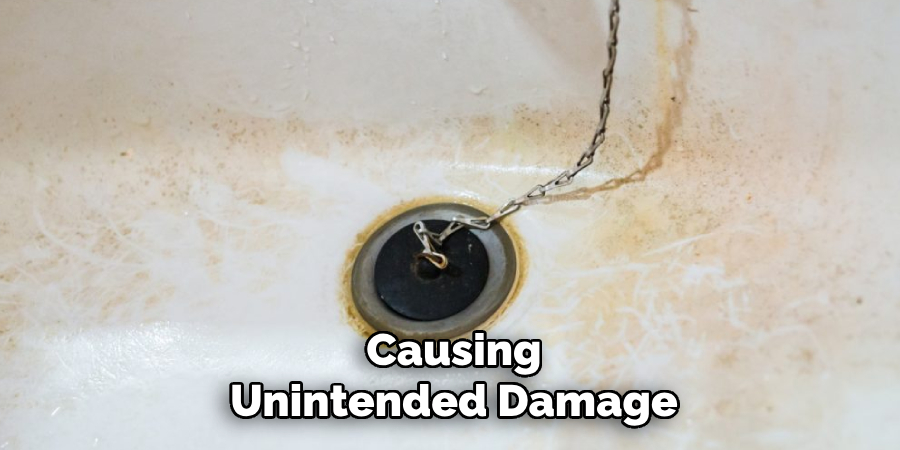
ensures compatibility and helps you assess how effectively it removes rust without harming the surface.
Use Protective Gear
When working with chemical cleaners, wearing proper protective gear is essential. Gloves will shield your hands from harsh substances, and ensuring proper ventilation prevents exposure to strong fumes that could irritate your eyes or respiratory system.
Avoid Abrasive Scrubbing on Delicate Surfaces
Harsh scrubbing tools, like steel wool or abrasive sponges, should not be used on delicate surfaces such as acrylic or fiberglass tubs. Excessive pressure or rough textures can scratch or permanently damage the material, making the surface more susceptible to future stains and wear.
By following these precautions, you can clean rust stains effectively while preserving the durability and appearance of your bathtub.
How to Get Rid of Rust Stains in Tub: Using Natural Cleaners to Remove Rust Stains
Natural cleaners are an effective and eco-friendly way to remove rust stains from your bathtub. These methods rely on safe household ingredients for you and the environment. Below are three simple and reliable techniques to tackle rust stains naturally:
Method 1: Baking Soda and Vinegar Paste
Combine equal parts baking soda and white vinegar in a bowl to form a thick paste. Apply the paste directly to the rust stains, ensuring full coverage. Let the mixture sit for about 30 minutes to allow the acidity of the vinegar to break down the
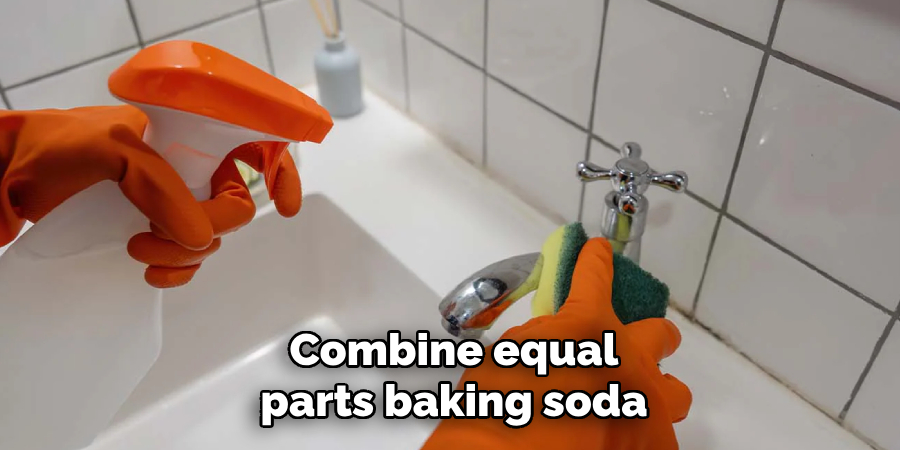
rust. Afterward, scrub the area gently with a soft sponge or brush, then rinse thoroughly with water. This method is particularly effective for light to moderate stains.
Method 2: Lemon Juice and Salt
Begin by sprinkling a generous amount of salt over the rust stain. Then, squeeze fresh lemon juice onto the salt until it is fully saturated. Allow the mixture to sit for at least an hour to give the natural acidity of the lemon time to dissolve the rust. Once the time is up, scrub the area carefully and rinse with warm water. This method not only removes rust but also leaves a pleasant citrus scent.
Method 3: Hydrogen Peroxide and Cream of Tartar
Mix cream of tartar with hydrogen peroxide to create a creamy paste. Apply the paste to the rust spots, ensuring it covers the stains completely. Leave it on for about 20 minutes to work its magic. Finally, wipe away the paste using a damp cloth or sponge and rinse the area thoroughly. This method is ideal for tougher rust stains.
By choosing these natural alternatives, you can effectively clean rust stains without relying on harsh chemicals, keeping your bathroom safe and eco-friendly.
Using Commercial Rust Removers
Commercial rust removers can be a highly effective solution when natural methods are not enough to tackle persistent rust stains. These products are specifically formulated to easily dissolve rust while saving time and effort.
Choosing the Right Rust Remover
When selecting a rust remover, it’s important to choose a non-abrasive product that is safe for use on tubs, sinks, or other affected areas. Trusted options like CLR or Iron OUT are designed for household use and can effectively eliminate rust
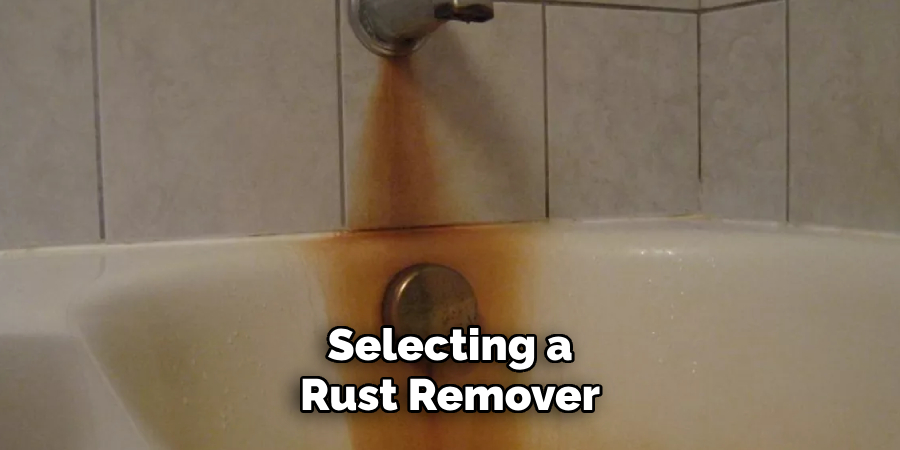
stains without damaging surfaces. Always check the label to ensure the product is compatible with your cleaning material.
Step-by-Step Application
- Apply the Product: The rust remover is applied directly to the stain. Use a generous amount to ensure full coverage over the affected area.
- Allow to Sit: Let the product sit undisturbed for 10 to 15 minutes, giving the formula time to break down the rust.
- Light Scrubbing: Using a sponge or a soft brush, gently scrub the stain to loosen and lift the rust. Avoid using abrasive tools that might damage the surface.
- Rinse Thoroughly: Rinse the area thoroughly with warm water to wash away any remaining cleaner once the rust has been removed.
Safety Considerations
When working with commercial rust removers, always read and follow the manufacturer’s instructions for proper use. Ensure that the area is well-ventilated to avoid inhaling fumes, and wear gloves to protect your skin from contact with potentially harsh chemicals. By taking these precautions, you can safely and effectively restore your surfaces to their original condition.
Preventing Future Rust Stains
Preventing rust stains in your tub is crucial for maintaining its appearance and extending its lifespan. One effective solution is to use a water softener or an iron filter in your plumbing system. These devices reduce the iron content in your water, one of the primary contributors to rust stains, thereby minimizing the chances of rust formation.
Another preventive measure is to replace rusty fixtures and pipes. If rusting is persistent, inspect your plumbing system to identify old or corroded pipes and faucets that might be introducing rust into your water. Upgrading these components can significantly reduce rust issues over time.
Additionally, keeping the tub dry after use is a simple yet effective habit to prevent rust buildup. Use a towel or squeegee to wipe down the tub after every use to eliminate standing water, which can accelerate the development of stains.
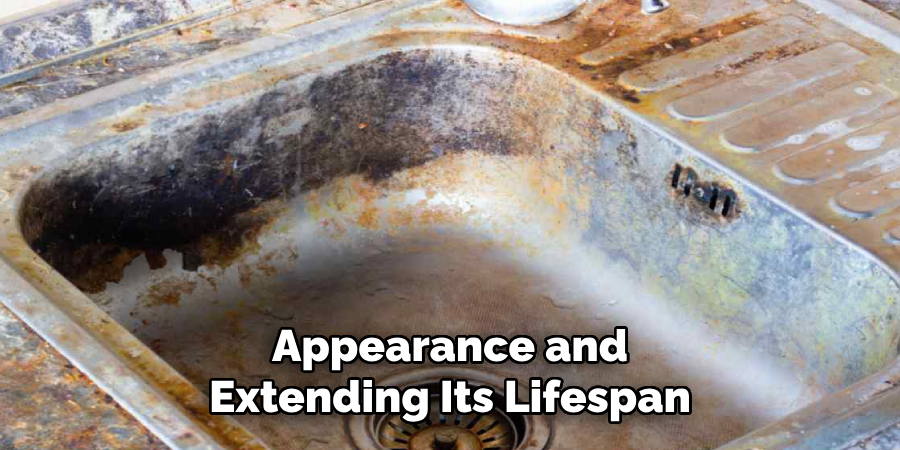
Finally, avoid leaving metal objects, such as razors or metal cans, in the bathtub area. Prolonged exposure to moisture can cause these items to rust, leading to stains on the tub’s surface. By implementing these preventive measures, you can keep your bathtub looking clean and free from rust for years to come.
Alternative Methods for Stubborn Rust Stains
For particularly stubborn rust stains, there are alternative methods that can provide effective results:
Pumice Stone for Porcelain Tubs
A pumice stone is a natural, abrasive tool that works well on porcelain surfaces. Wet the pumice stone and gently rub it over the rust stains. This method helps lift the rust without causing damage to the porcelain. Be cautious and test the stone in an inconspicuous area before proceeding to ensure it doesn’t scratch the surface.
Oxalic Acid-Based Cleaners
Oxalic acid-based cleaners are highly effective for removing severe rust stains. These cleaners work by dissolving the iron compounds responsible for the stains. However, they should be used with caution due to their potency. Always follow the manufacturer’s instructions, wear protective gloves, and ensure proper ventilation when using these products.
DIY Rust Stain Remover with Borax and Lemon
A homemade borax and lemon juice solution can be safe and effective. Mix borax powder with enough lemon juice to form a thick paste. Apply the paste to the rust stain and allow it to sit for 15-20 minutes. Then, scrub with a brush or sponge before rinsing thoroughly. This method leverages the natural cleaning power of citric acid and the abrasiveness of borax to tackle tough stains sustainably.
Conclusion
Rust stains in tubs can be effectively addressed using natural methods, commercial cleaners, or alternative treatments tailored to the severity of the stains and the type of tub. Regular cleaning, water filtration systems, and proper maintenance are vital to prevent these stains from recurring. Whether using DIY solutions like borax and lemon juice or oxalic acid-based cleaners, there is a method for every situation. By understanding how to get rid of rust stains in tub, you can restore its appearance and prolong its lifespan, ensuring a clean and welcoming bathroom environment. Choose the method that best suits your needs.

